Process Analysis and Topography Evaluation for Monocrystalline Silicon Laser Cutting-Off
Abstract
1. Introduction
2. Experiment Setup
2.1. Materials and Methods
2.1.1. Wafer Material
2.1.2. Wafer-Cutting Morphology and the Judgment Method
2.1.3. Laser Processing Equipment
2.1.4. Selection of the Measuring Instrument
2.2. Laser Cutting Process Parameters Selection
2.3. Overall Experiments Design
3. Analysis of the Wafer Cutting Mechanism
3.1. Wafer Cutting Process Analysis
3.1.1. Judgment of the Threshold Value of Laser Cutting Times
3.1.2. Determination of Laser Cutting Times
3.1.3. Analysis of Laser Cutting Quality
3.2. Micromorphology and Machining Affected Zone Analysis
3.2.1. Material Crack Width Analysis
3.2.2. Material Machining Affected Zone Analysis
3.2.3. Analysis of Crack Width and Morphology after Chip Removal
4. Laser Experiment and Analysis
4.1. Process Analysis of the Influence of Laser Cutting Speed
4.1.1. Process Parameter Design
4.1.2. Morphology Analysis before Chip Removal
4.1.3. Morphology Analysis after Chip Removal
4.2. Process Analysis of the Influence of Laser Frequency
4.2.1. Process Parameter Design
4.2.2. Morphology Analysis before Chip Removal
4.2.3. Morphology Analysis after Chip Removal
4.3. Process Analysis of the Influence of Laser Pulse Width
4.3.1. Process Parameter Design
4.3.2. Morphology Analysis before Chip Removal
4.3.3. Morphology Analysis after Chip Removal
5. Conclusions
Author Contributions
Funding
Data Availability Statement
Conflicts of Interest
References
- Li, W.; Jiao, Y.; Jiang, H.-Y.; Ren, Y.-H.; Ibrahim, A.M.M. Ahmed Mohamed Mahmoud Ibrahim, Investigation of mechanical force acting on the surface modified-substrate layer area during the chemical-mechanical micro-grinding of monocrystalline silicon. Int. J. Mech. Sci. 2022, 228, 107482. [Google Scholar] [CrossRef]
- Wang, Q.; Yao, P.; Li, Y.; Jiang, L.; Xu, J.; Liang, S.; Chu, D.; He, W.; Huang, C.; Zhu, H.; et al. Inverted pyramid structure on monocrystalline silicon processed by wet etching after femtosecond laser machining in air and deionized water. Opt. Laser Technol. 2023, 157, 108647. [Google Scholar] [CrossRef]
- Li, C.; Piao, Y.; Zhang, F.; Zhang, Y.; Hu, Y.; Wang, Y. Understand anisotropy dependence of damage evolution and material removal during nanoscratch of MgF2 single crystals. Int. J. Extrem. Manuf. 2023, 5, 015101. [Google Scholar] [CrossRef]
- Priolo, F.; Gregorkiewicz, T.; Galli, M.; Krauss, T. Silicon nanostructures for photonics and photovoltaics. Nat. Nanotechnol. 2014, 271, 101038. [Google Scholar] [CrossRef] [PubMed]
- Guo, Y.; Yang, X.; Kang, J.; Li, M.; Xie, Q.; Xiao, J.; Zhang, W. Experimental investigations on the laser-assisted machining of single crystal Si for optimal machining. Opt. Laser Technol. 2021, 141, 107113. [Google Scholar] [CrossRef]
- Wang, J.Q.; Yan, Y.D.; Li, C.; Geng, Y.Q. Material removal mechanism and subsurface characteristics of silicon 3D nanomilling. Int. J. Mech. Sci. 2023, 242, 108020. [Google Scholar] [CrossRef]
- Zhang, W.J.; Chen, J.S.; Li, S.; Wu, Y.H.; Zhang, P.L.; Yu, Z.S.; Yue, Z.H.; Chun, Y.; Lu, H. Electronic and mechanical properties of monocrystalline silicon doped with trace content of N or P: A first-principles study. Solid State Sci. 2021, 120, 106723. [Google Scholar] [CrossRef]
- Bian, D.; Song, E.M.; Ni, Z.F.; Qian, S.; Zhao, Y. Optimization of CMP processing parameters for Si based on response surface method. Diam. Abras. Eng. 2022, 42, 745–752. [Google Scholar]
- Wu, C.; Li, B.; Liu, Y.; Liang, S.Y. Surface roughness modeling for grinding of silicon carbide ceramics considering co-existence of brittleness and ductility. Int. J. Mech. Sci. 2017, 133, 167–177. [Google Scholar] [CrossRef]
- Uddin, M.S.; Seah, K.H.W.; Rahman, M.; Li, X.P.; Liu, K. Performance of single crystal diamond tools in ductile mode cutting of silicon. J. Mater. Process. Technol. 2006, 185, 24–30. [Google Scholar] [CrossRef]
- Dong, Z.; Yan, Y.; Peng, G.; Li, C.; Geng, Y. Effects of sandwiched film thickness and cutting tool water contact angle on the processing outcomes in nanoskiving of nanowires. Mater. Des. 2023, 225, 111438. [Google Scholar] [CrossRef]
- Wang, Y.; Zhao, B.C.; Huang, S.J.; Qian, Z.F. Study on the subsurface damage depth of monocrystalline silicon in ultrasonic vibration assisted diamond wire sawing. Eng. Fract. Mech. 2021, 258, 108077. [Google Scholar] [CrossRef]
- Toshiro, K.; Hideo, A.; Osamu, O.; Yin, S.H.; Ren, Y.H. Challenges of future high-precision polishing methods for hard-to-process materials by the fusion of environmental control and plasma technology. Diam. Abras. Eng. 2022, 42, 637–649. [Google Scholar]
- Costa, E.C.; Weingaertner, W.L.; Xavier, F.A. Influence of single diamond wire sawing of photovoltaic monocrystalline silicon on the feed force, surface roughness and micro-crack depth. Mater. Sci. Semicond. Process. 2022, 143, 106525. [Google Scholar] [CrossRef]
- Costa, E.C.; Xavier, F.A.; Knoblauch, R.; Binder, C.; Weingaertner, W.L. Effect of cutting parameters on surface integrity of monocrystalline silicon sawn with an endless diamond wire saw. Sol. Energy 2020, 207, 640–650. [Google Scholar] [CrossRef]
- Wang, B.; Melkote, S.N.; Wang, P.; Saraogi, S. Effect of speed on material removal behavior in scribing of monocrystalline silicon. Precis. Eng. 2020, 66, 315–323. [Google Scholar] [CrossRef]
- Guo, X.Y.; Xu, Y.C.; Cao, J.F.; Zhu, J.H.; Zhao, Y.J.; Zhao, J.W.; Shi, C.Y. Laser dressing technology for micro-grooves on the surface of metal-bonded diamond wheels. Diam. Abras. Eng. 2022, 42, 364–372. [Google Scholar]
- Naresh; Khatak, P. Laser cutting technique: A literature review. Mater. Today Proc. 2022, 56, 2484–2489. [Google Scholar] [CrossRef]
- Li, C.; Hu, Y.; Zhang, F.; Geng, Y.; Meng, B. Molecular dynamics simulation of laser assisted grinding of GaN crystals. Int. J. Mech. Sci. 2023, 239, 107856. [Google Scholar] [CrossRef]
- Marks, M.R.; Cheong, K.Y.; Hassan, Z. A review of laser ablation and dicing of Si wafers. Precis. Eng. 2022, 73, 377–408. [Google Scholar] [CrossRef]
- Wu, C.; Li, J.; Hou, T.Y.; Yu, N.B.; Gao, X.J. Effect of pad and slurry on fixed abrasive polishing of gallium oxide crystal. Diam. Abras. Eng. 2022, 42, 720–727. [Google Scholar]
- Zhao, C.Y.; Cai, Y.C.; Ding, Y.; Yang, L.J.; Wang, Z.L.; Wang, Y. Investigation on the crack fracture mode and edge quality in laser dicing of glass-anisotropic silicon double-layer wafer. J. Mater. Process. Technol. 2020, 275, 116356. [Google Scholar] [CrossRef]
- Berhe, M.G.; Oh, H.G.; Park, S.-K.; Lee, D. Laser cutting of silicon anode for lithium-ion batteries. J. Mater. Res. Technol. 2022, 16, 322–334. [Google Scholar] [CrossRef]
- Zhou, R.; Lin, S.; Ding, Y.; Yang, H.; Keng, K.O.Y.; Hong, M. Enhancement of laser ablation via interacting spatial double-pulse effect. Opto-Electron. Adv. 2018, 1, 180014. [Google Scholar] [CrossRef]
- Ding, Y.; Yang, L.J.; Hong, M.H. Enhancement of pulsed laser ablation assisted with continuous wave laser irradiation. Sci. China Phys. Mech. Astron. 2019, 62, 70–78. [Google Scholar] [CrossRef]
- Kumagai, M.; Uchiyama, N.; Ohmura, E.; Sugiura, R.; Atsumi, K.; Fukumitsu, K. Advanced dicing technology for semiconductor wafer—Stealth dicing. Semicond. Manuf. 2007, 20, 259–265. [Google Scholar] [CrossRef]
- Huang, Y.Q.; Cao, L.; Zhang, W.L.; Hang, T.; Li, M.; Wu, Y.W. Nano-twins and stacking faults induced by picosecond laser dicing with low fluence strengthening monocrystalline silicon. Mater. Lett. 2023, 334, 133719. [Google Scholar] [CrossRef]
- Duc, D.H.; Naoki, I.; Kazuyoshi, F. A study of near-infrared nanosecond laser ablation of silicon carbide. Int. J. Heat Mass Transf. 2013, 65, 713–718. [Google Scholar] [CrossRef]
- Morar, N.I.; Roy, R.; Gray, S.; Nicholls, J.; Mehnen, J. Modelling the influence of laser drilled recast layer thickness on the fatigue performance of CMSX-4. Procedia Manuf. 2018, 16, 67–74. [Google Scholar] [CrossRef]
- Yang, L.J.; Wang, Y.; Tian, Z.G.; Cai, N. YAG laser cutting soda-lime glass with controlled fracture and volumetric machining absorption. Int. J. Mach. Tools Manuf. 2010, 50, 849–859. [Google Scholar] [CrossRef]
- Ueda, T.; Yamada, K.; Oiso, K.; Hosokawa, A. Thermal stress cleaving of brittle materials by laser beam. CIRP Ann. 2002, 51, 149–152. [Google Scholar] [CrossRef]
- Yamada, K.; Nishioka, S.; Hosokawa, A.; Ueda, T. Cleaving process of brittle materials with pulsed YAG Laser: Thermal stress analysis in cleaving process of silicon wafer. Jpn. Soc. Precis. Eng. 2003, 69, 120–124. [Google Scholar] [CrossRef]
- Haupt, O.; Siegel, F.; Schoonderbeek, A.; Richter, L.; Kling, R.; Ostendorf, A. Laser dicing of silicon: Comparison of ablation mechanisms with a novel technology of thermally induced stress. Laser Microfabr. Nanomanufact. 2008, 3, 135–140. [Google Scholar] [CrossRef]
- Yamada, K.; Ueda, T.; Hosokawa, A.; Yamane, Y.; Sekiya, K. Thermal damage of silicon wafer in thermal cleaving process with pulsed laser and CW laser. Int. Soc. Opt. Photonics 2006, 6107, 61070H. [Google Scholar]
- Shalupaev, S.; Serdyukov, A.; Mityurich, G.; Aleksiejuk, M.; Nikitjuk, Y.; Sereda, A. Modeling of mechanical influence of double-beam laser on single-crystalline silicon. Arch. Metall. Mater. 2013, 58, 1381–1385. [Google Scholar] [CrossRef]
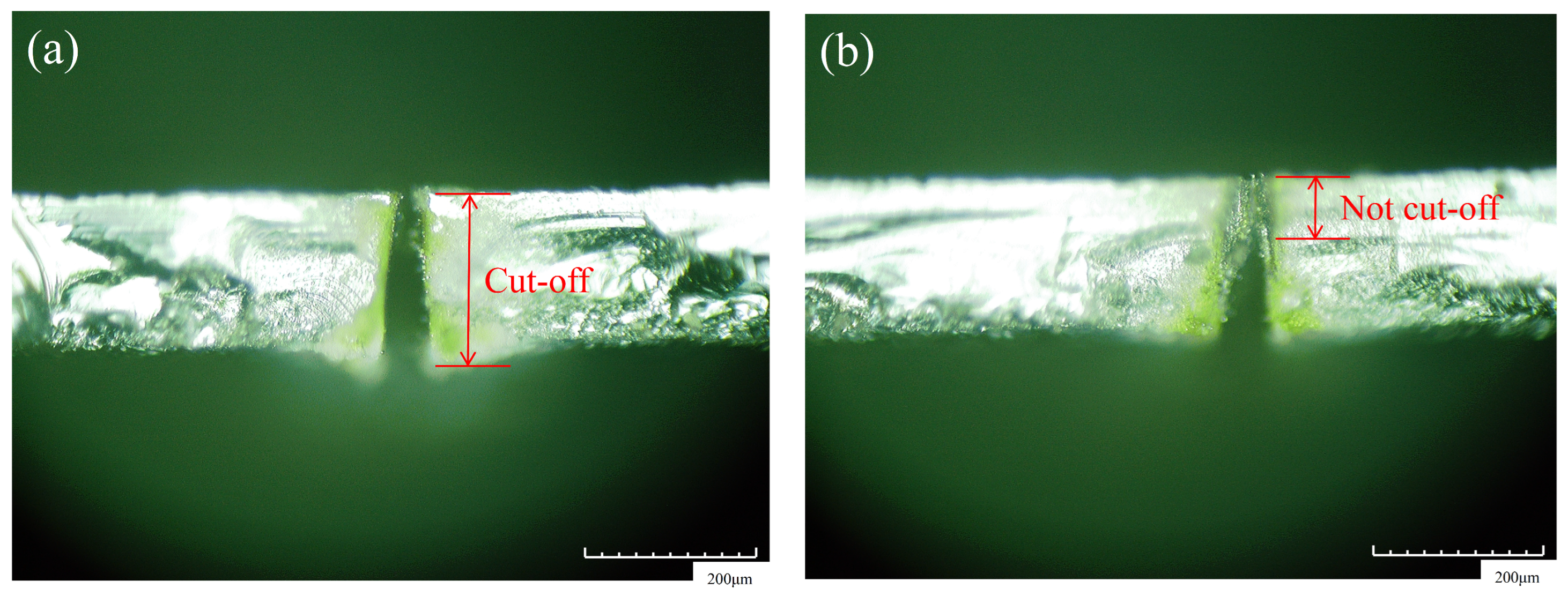
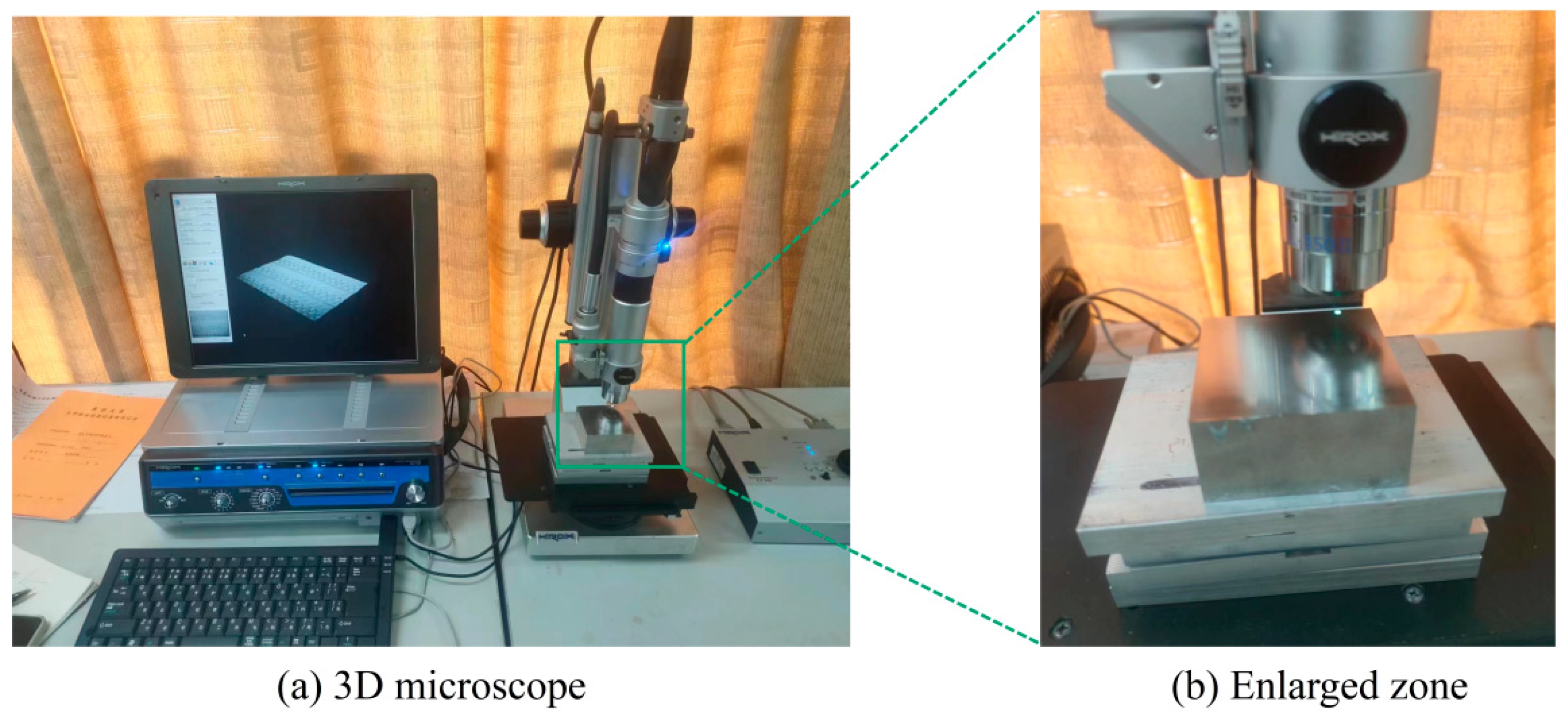

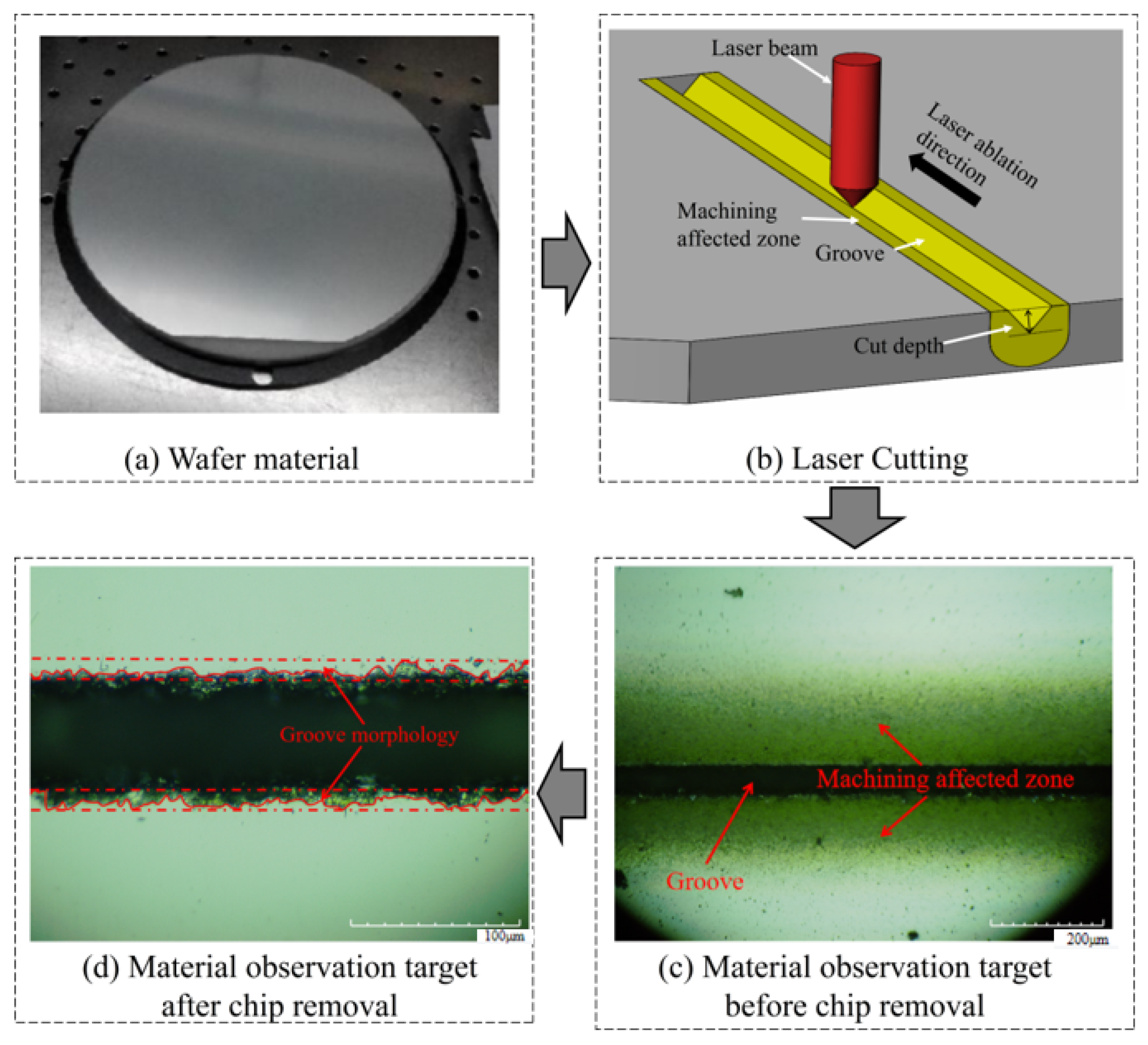
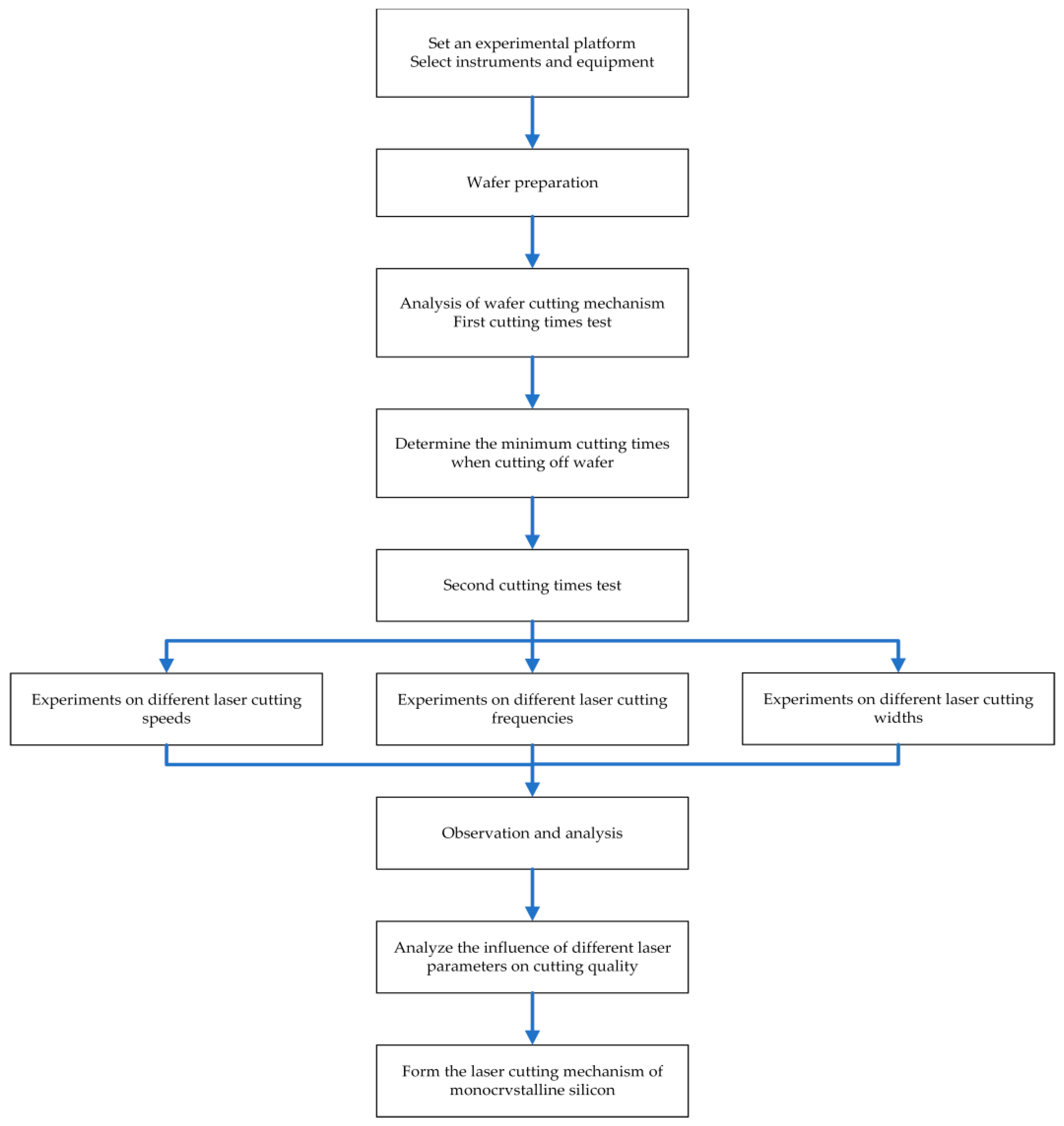
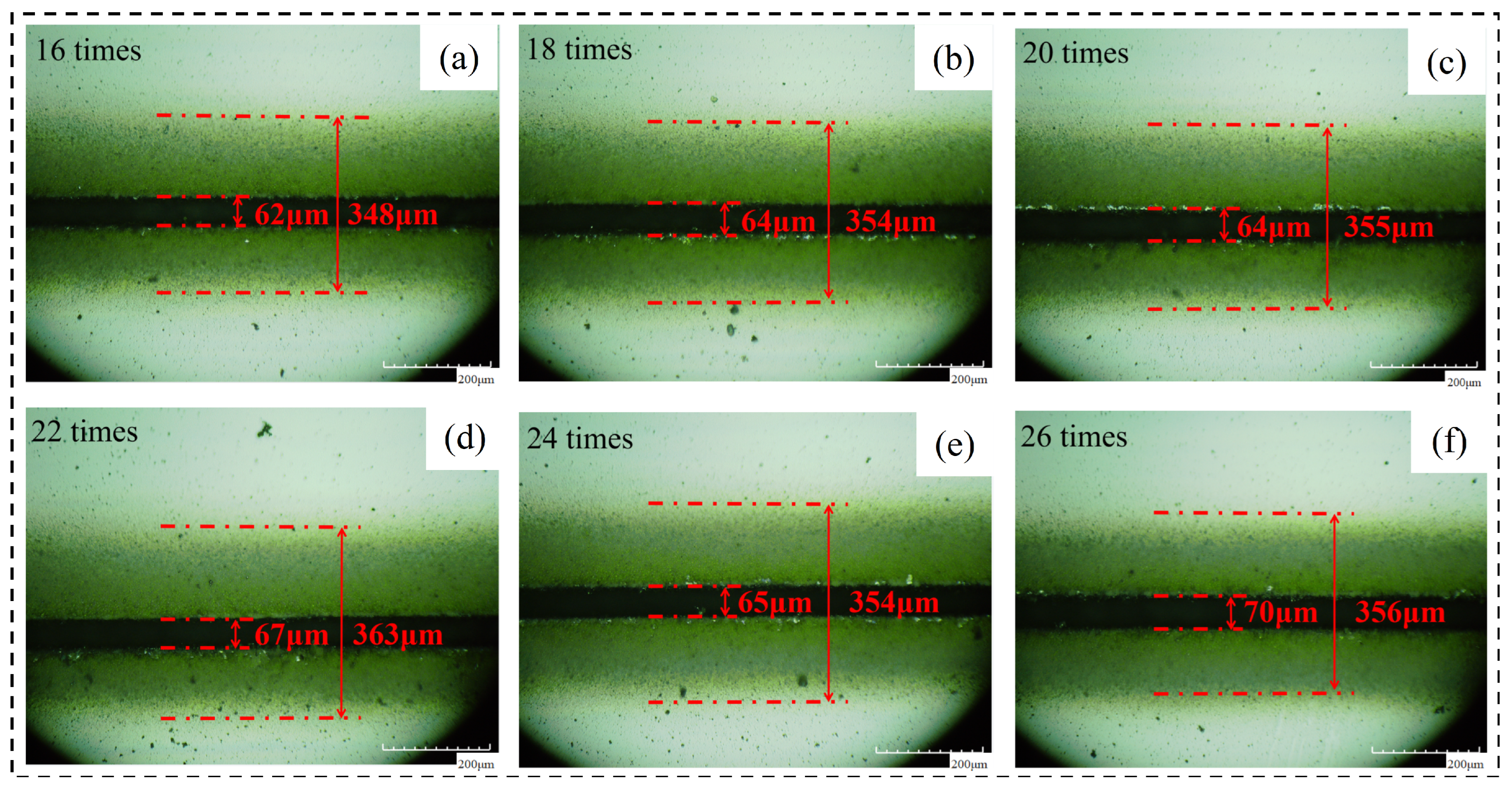
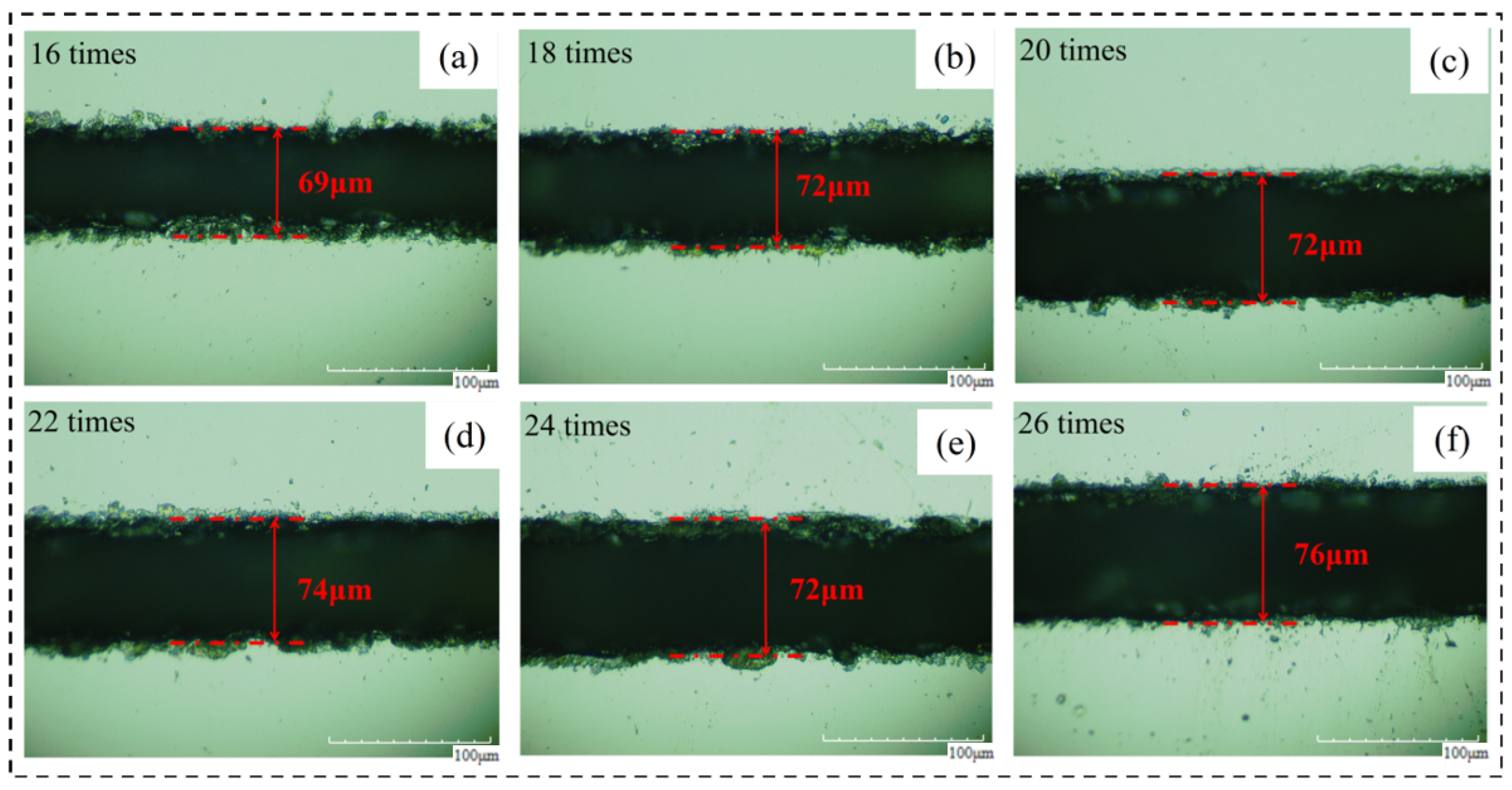
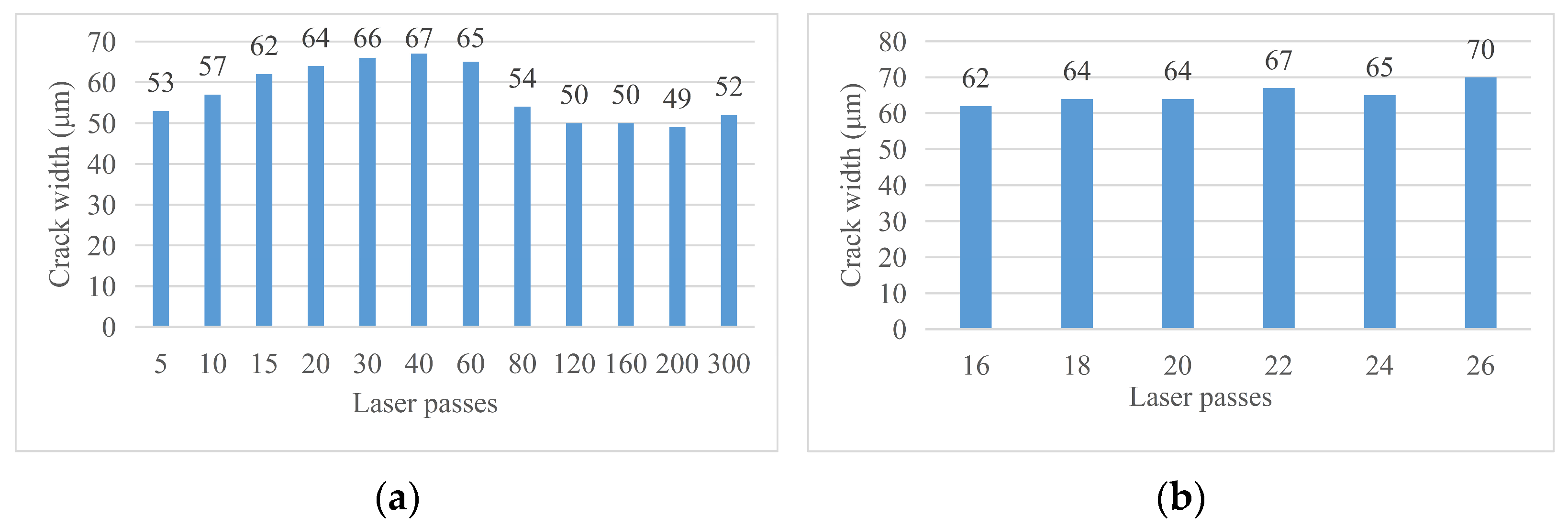
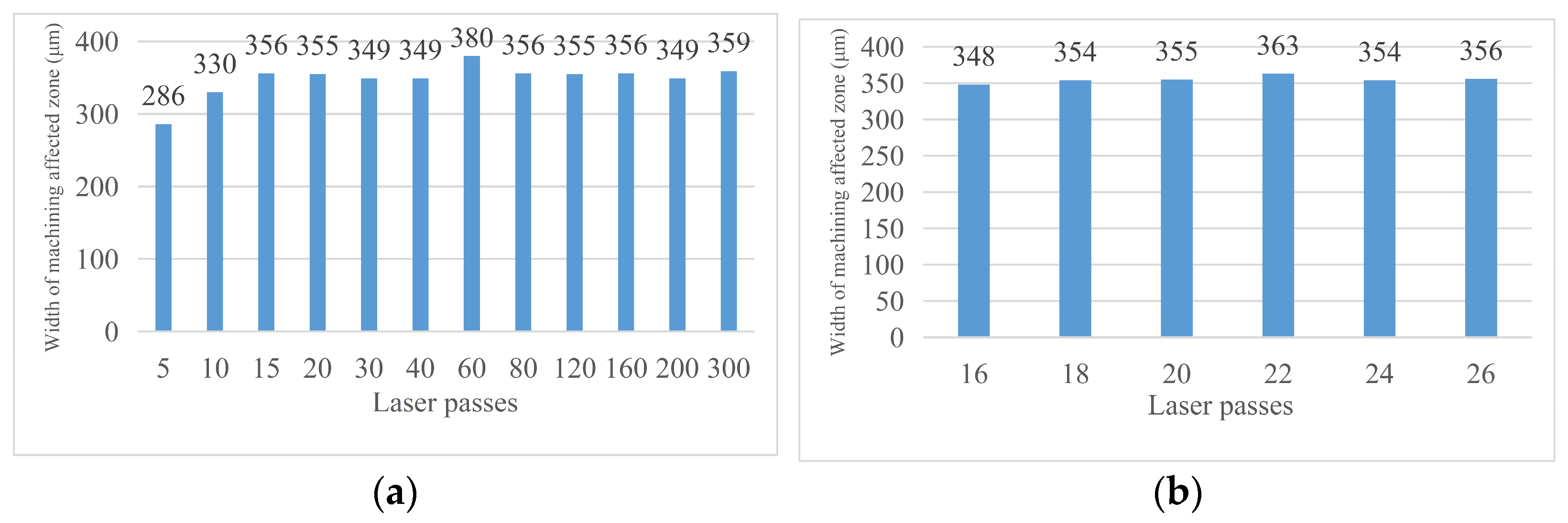
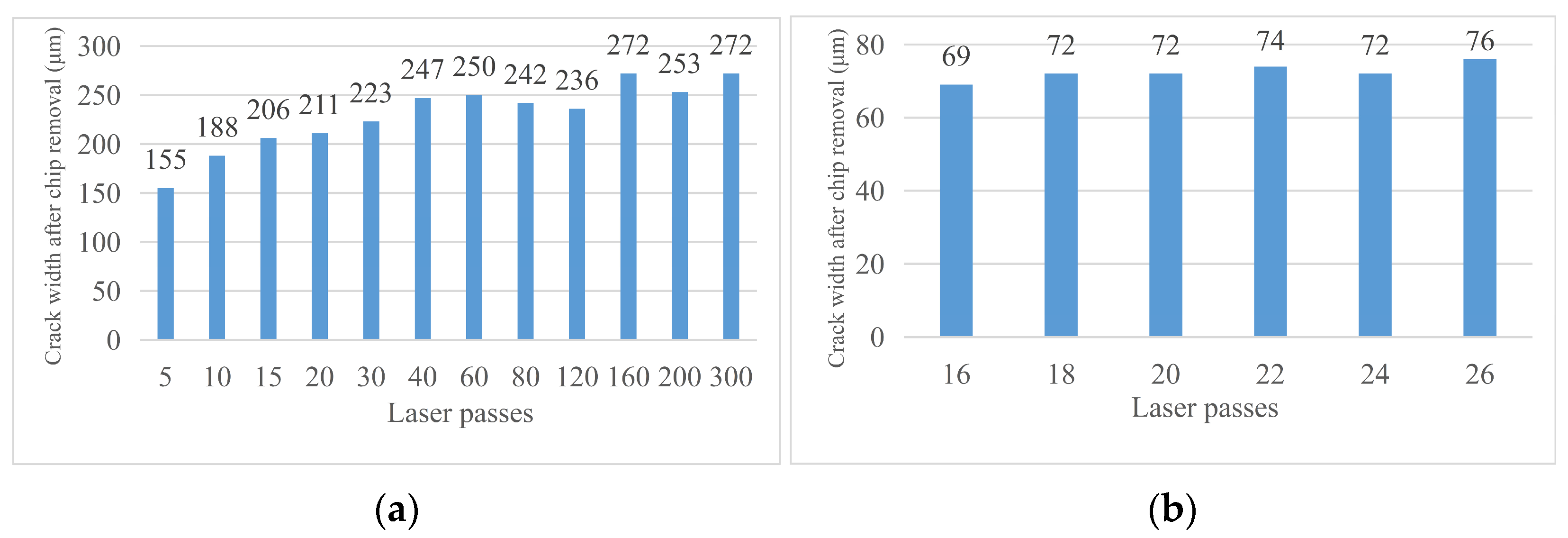
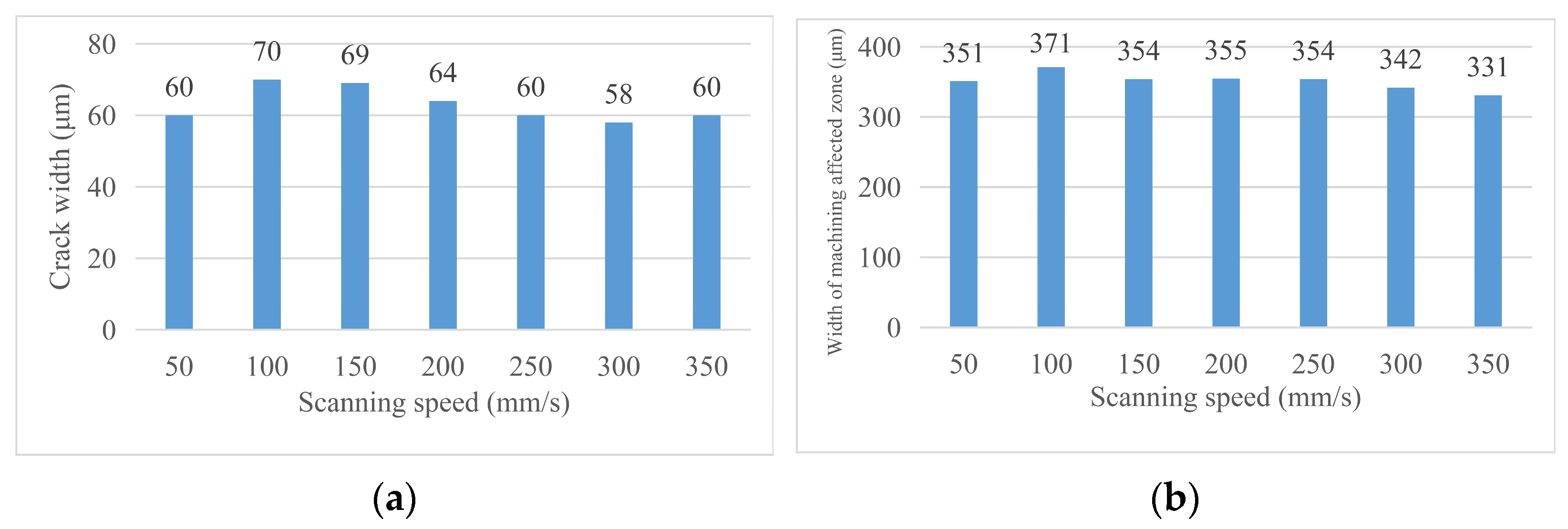
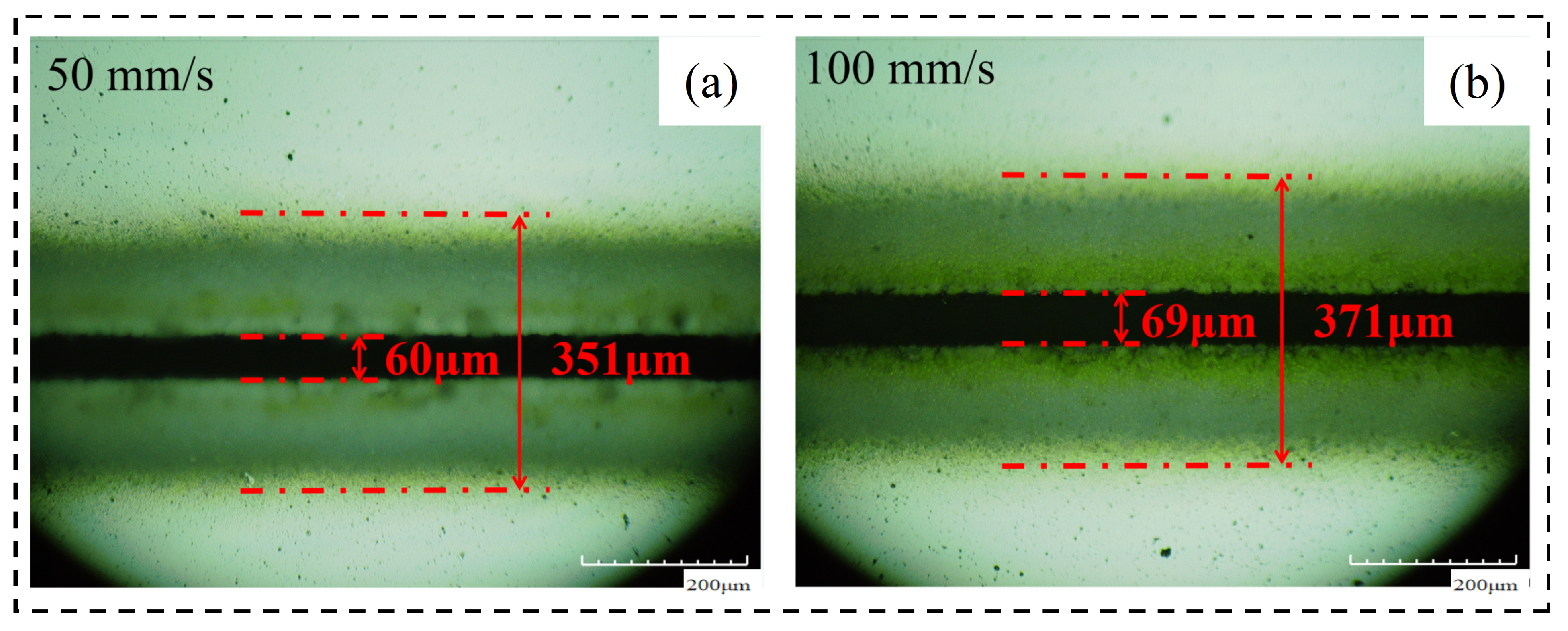

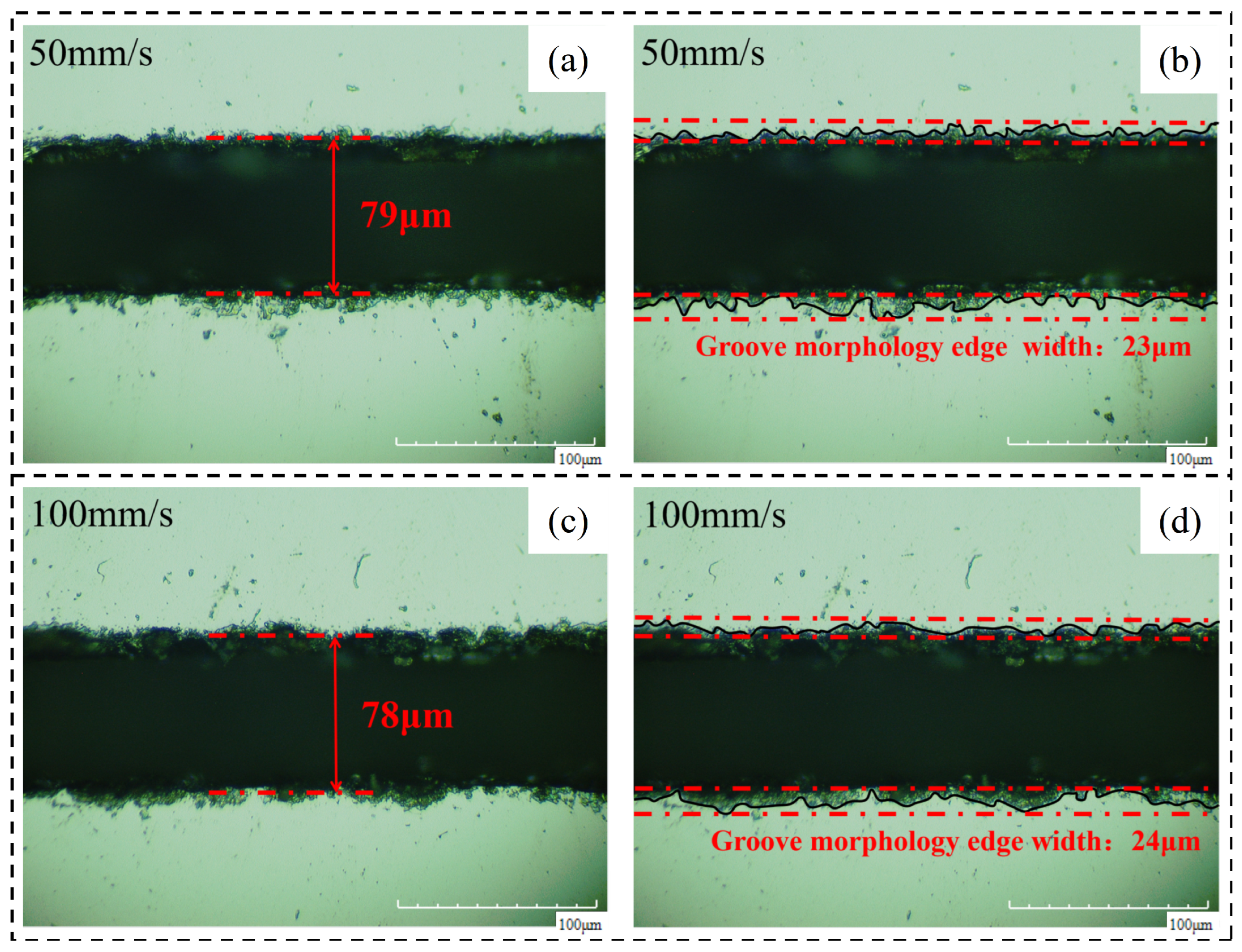

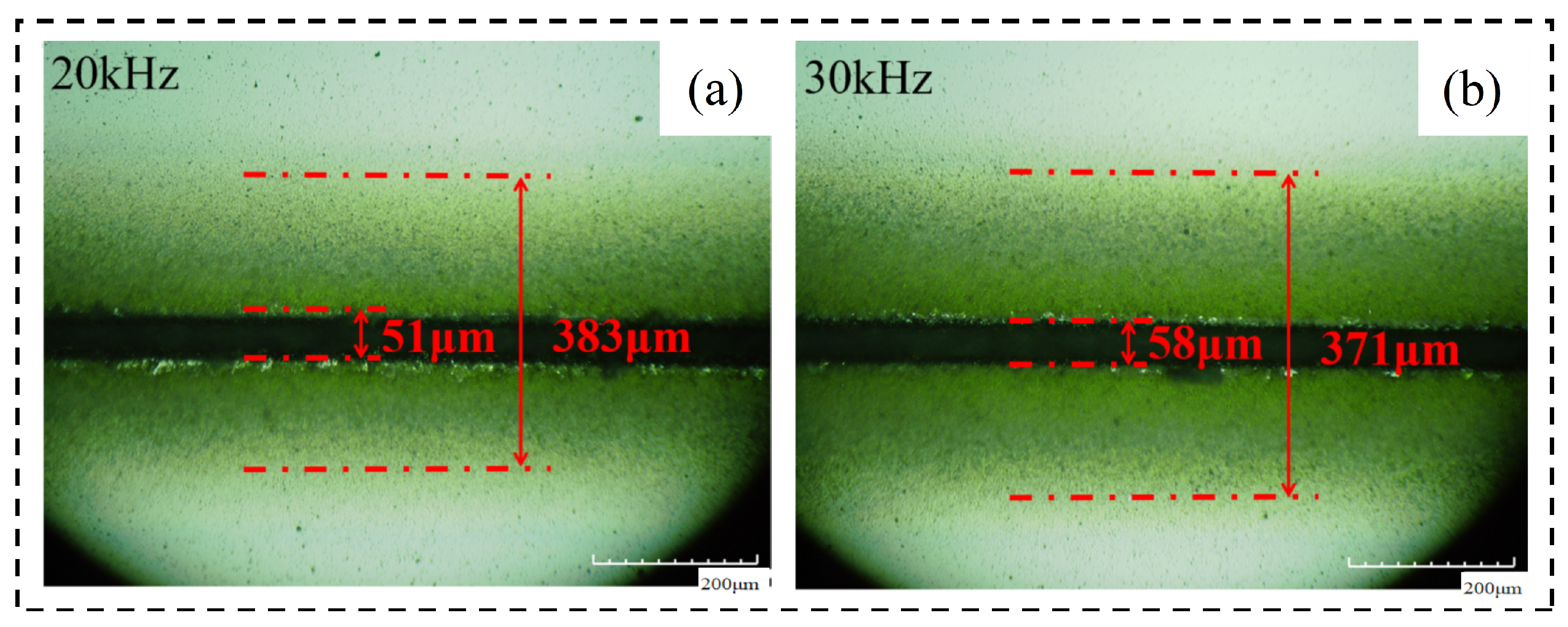
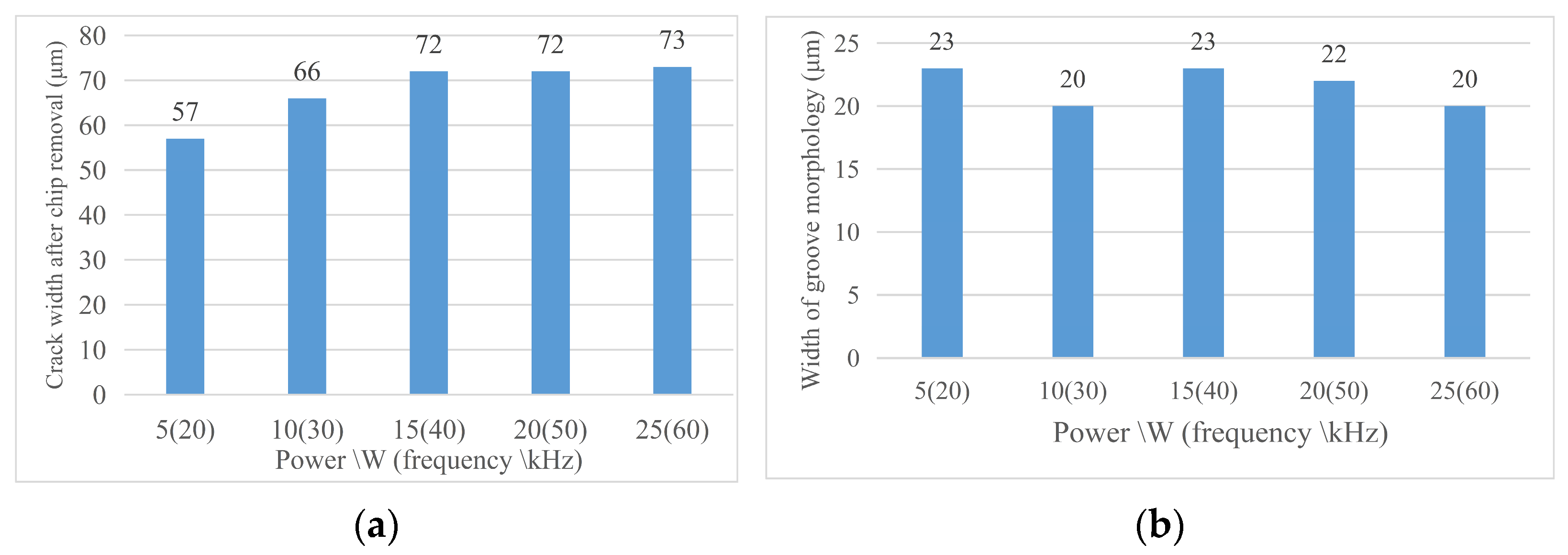
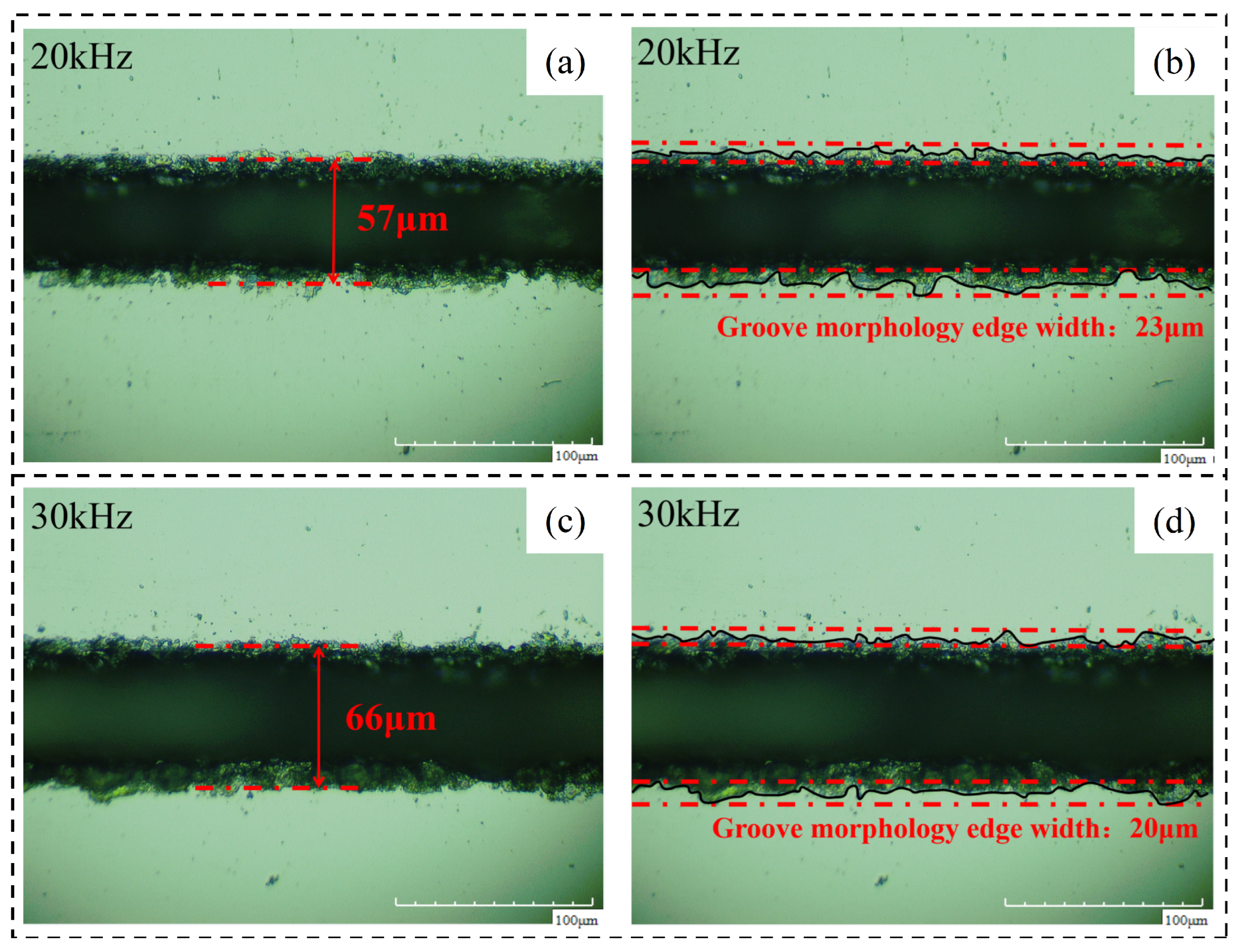
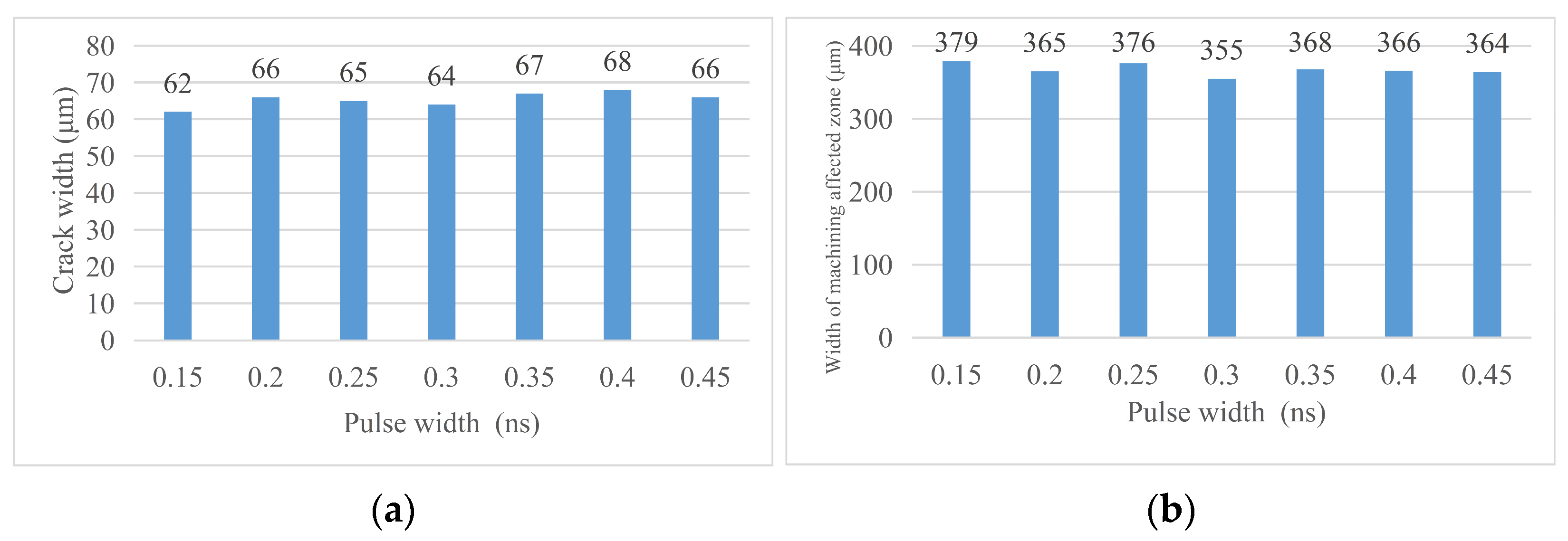
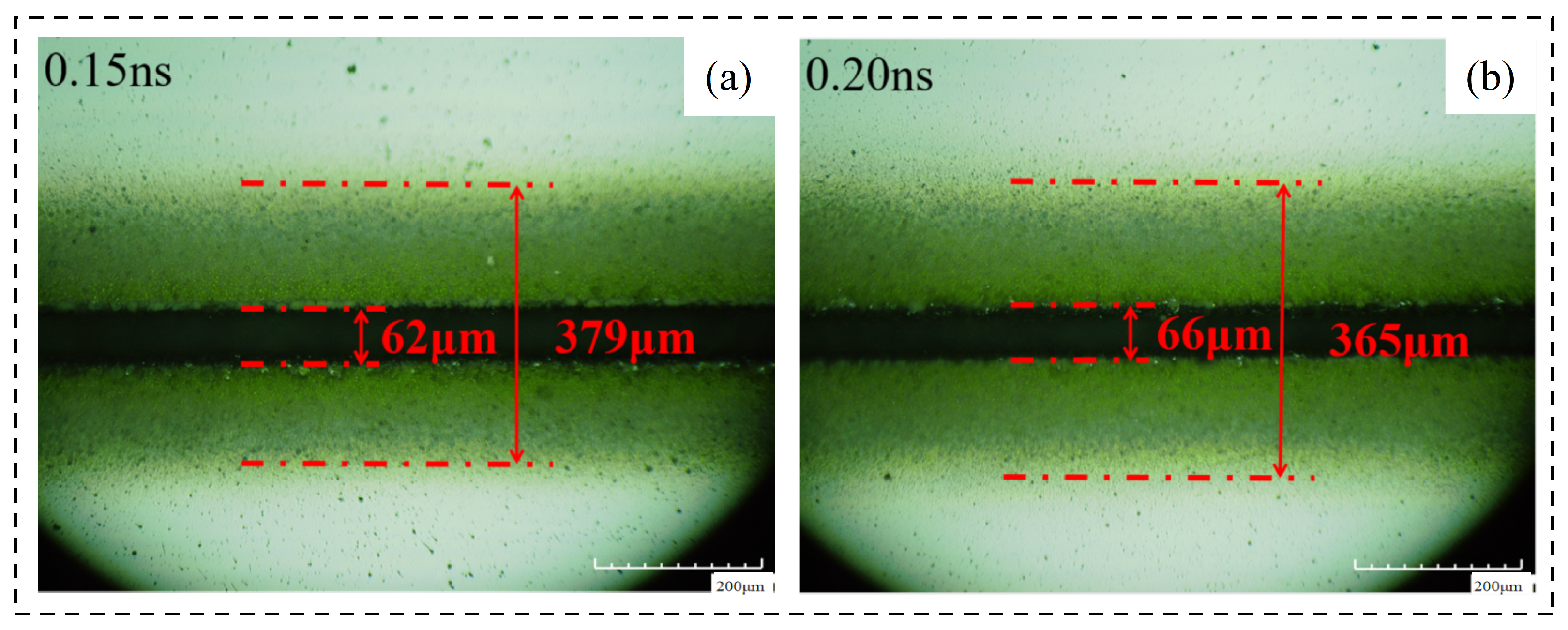
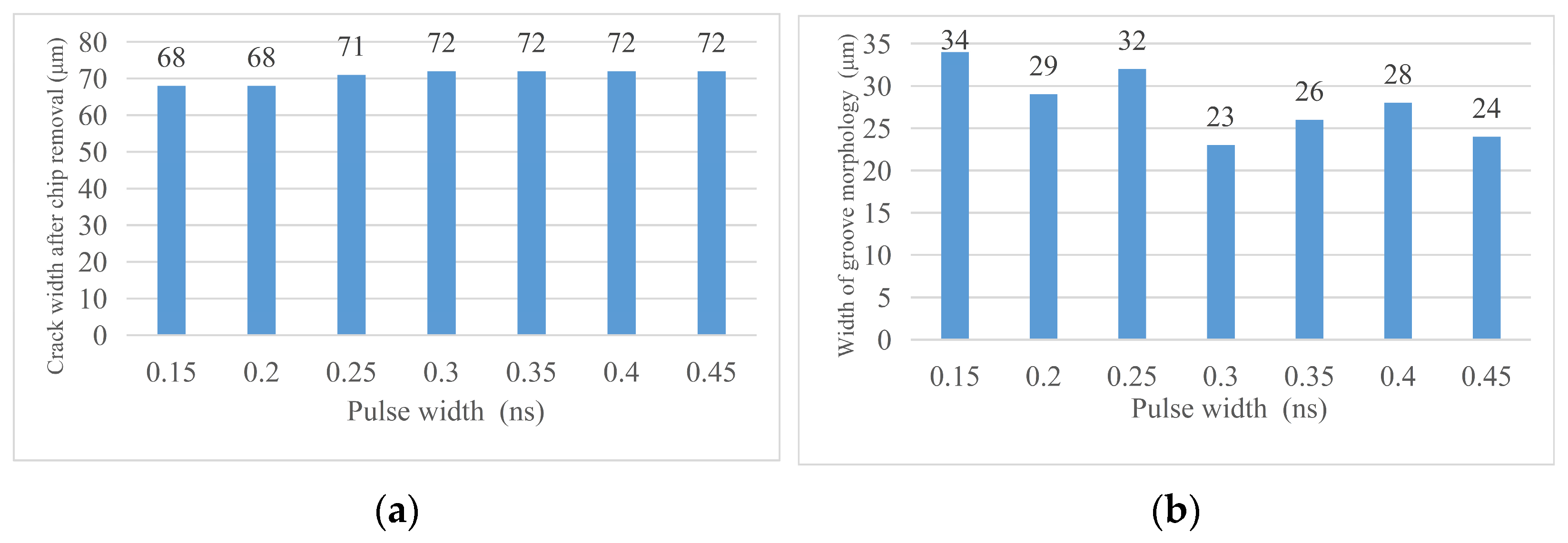
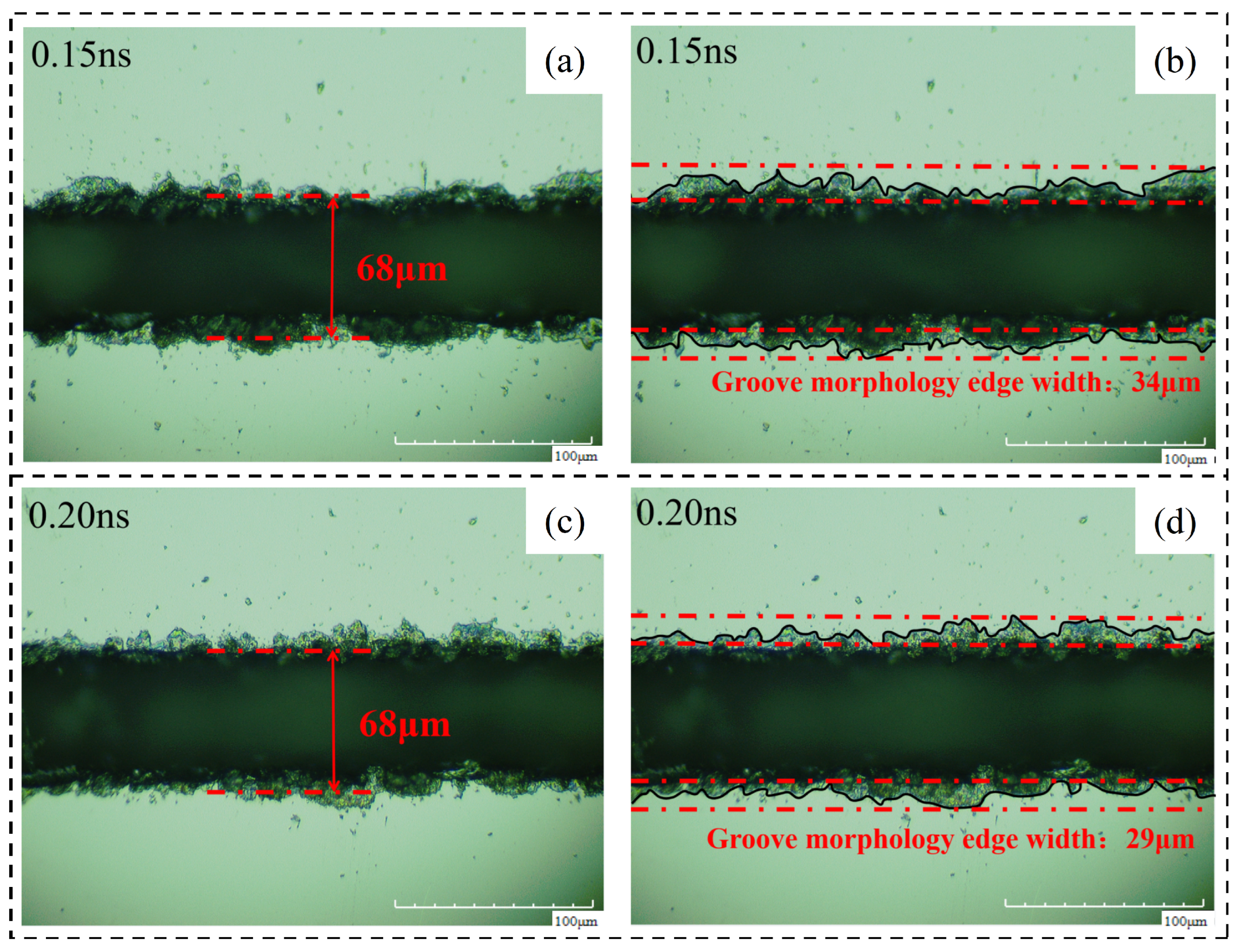
| Basic Parameter | |||
|---|---|---|---|
| Type | Single side polished silicon wafer | Thickness | 200 ± 10 μm |
| Model/crystal orientation | P<100> | Diameter | 100 ± 0.4 mm |
| Growth method | CZ | Resistivity | 1–10 Ωcm |
| Basic Parameters | |||
|---|---|---|---|
| Output power | >5 W@50 kHz | Working temperature | 10–35 °C |
| Single pulse energy | >125 μJ@40 kHz | Cooling method | Water |
| Pulse width | 16 ± 2 ns@50 kHz | Voltage | 110/220 V, 50/60 Hz |
| Start time | <15 min | Focus (z-axis direction) | 33 cm |
| Repetition frequency | 20 kHz–200 kHz | Spatial mode | TEM00 (M2 ≤ 1.2) |
| Power stability | ≤3% rms | Pulse stability | ≤3% rms |
| Beam diameter | <8 m | Spot divergence angle | ≤1 mrad |
| Beam directivity | <25 μrad | Rad spot roundness | ≥90% |
| Manufacturer | Wuhan Huaray Precision Laser Co., Ltd. | Nation | Wuhan, China |
| Parameters | |
|---|---|
| Scanning speed/mm·s−1 | 50, 100, 150, 200, 250, 300, 350 |
| Laser frequency/kHz | 20, 30, 40, 50, 60 |
| Pulse width/ns | 0.15, 0.2, 0.25, 0.3, 0.35, 0.4, 0.45 |
| Laser passes | 20 |
| Laser Passes | Crack Width/μm | Width of Machining Affected Zone/μm | Crack Width after Chip Removal/μm | Whether It Is Cut Off |
|---|---|---|---|---|
| 5 | 53 | 286 | 155 | No |
| 10 | 57 | 330 | 188 | No |
| 15 | 62 | 356 | 206 | No |
| 20 | 64 | 355 | 211 | Yes |
| 30 | 66 | 349 | 223 | Yes |
| 40 | 67 | 349 | 247 | Yes |
| 60 | 65 | 380 | 250 | Yes |
| 80 | 54 | 356 | 242 | Yes |
| 120 | 50 | 355 | 236 | Yes |
| 160 | 50 | 356 | 272 | Yes |
| 200 | 49 | 349 | 253 | Yes |
| 300 | 52 | 359 | 272 | Yes |
| Laser Passes | Crack Width/μm | Width of Machining Affected Zone/μm | Crack Width after Chip Removal/μm | Width of Groove Morphology/μm | Whether It Is Cut Off |
|---|---|---|---|---|---|
| 16 | 62 | 348 | 69 | 24 | No |
| 18 | 64 | 354 | 72 | 24 | No |
| 20 | 64 | 355 | 72 | 23 | Yes |
| 22 | 67 | 363 | 74 | 27 | Yes |
| 24 | 65 | 354 | 72 | 28 | Yes |
| 26 | 70 | 356 | 76 | 20 | Yes |
| Scanning Speed/mm·s−1 | Crack Width/μm | Width of Machining Affected Zone/μm | Crack Width after Chip Removal/μm | Width of Groove Morphology/μm | Whether It Is Cut Off |
|---|---|---|---|---|---|
| 50 | 60 | 351 | 79 | 23 | Yes |
| 100 | 70 | 371 | 78 | 24 | Yes |
| 150 | 69 | 354 | 75 | 23 | Yes |
| 200 | 64 | 355 | 72 | 23 | Yes |
| 250 | 60 | 354 | 67 | 21 | Yes |
| 300 | 58 | 342 | 64 | 32 | No |
| 350 | 60 | 331 | 65 | 29 | No |
| Frequency/kHz | 20 | 30 | 40 | 50 | 60 |
| Average power/W | 5 | 10 | 15 | 20 | 25 |
| Power/W (Frequency/kHz) | Crack Width/μm | Width of Machining Affected Zone/μm | Crack Width after Chip Removal/μm | Width of Groove Morphology/μm | Cut Off |
|---|---|---|---|---|---|
| 5 (20) | 51 | 383 | 57 | 23 | No |
| 10 (30) | 58 | 371 | 66 | 20 | Yes |
| 15 (40) | 64 | 355 | 72 | 23 | Yes |
| 20 (50) | 71 | 337 | 72 | 22 | Yes |
| 25 (60) | 69 | 285 | 73 | 20 | Yes |
| Crack Width/μm | Width of Machining Affected Zone/μm | Crack Width after Chip Removal/μm | Width of Groove Morphology/μm | Whether It Is Cut Off | |
|---|---|---|---|---|---|
| 0.15 | 62 | 379 | 68 | 34 | Yes |
| 0.2 | 66 | 365 | 68 | 29 | Yes |
| 0.25 | 65 | 376 | 71 | 32 | Yes |
| 0.3 | 64 | 355 | 72 | 23 | Yes |
| 0.35 | 67 | 368 | 72 | 26 | Yes |
| 0.4 | 68 | 366 | 72 | 28 | Yes |
| 0.45 | 66 | 364 | 72 | 24 | Yes |
Disclaimer/Publisher’s Note: The statements, opinions and data contained in all publications are solely those of the individual author(s) and contributor(s) and not of MDPI and/or the editor(s). MDPI and/or the editor(s) disclaim responsibility for any injury to people or property resulting from any ideas, methods, instructions or products referred to in the content. |
© 2023 by the authors. Licensee MDPI, Basel, Switzerland. This article is an open access article distributed under the terms and conditions of the Creative Commons Attribution (CC BY) license (https://creativecommons.org/licenses/by/4.0/).
Share and Cite
Liu, F.; Yu, A.; Wu, C.; Liang, S.Y. Process Analysis and Topography Evaluation for Monocrystalline Silicon Laser Cutting-Off. Micromachines 2023, 14, 1542. https://doi.org/10.3390/mi14081542
Liu F, Yu A, Wu C, Liang SY. Process Analysis and Topography Evaluation for Monocrystalline Silicon Laser Cutting-Off. Micromachines. 2023; 14(8):1542. https://doi.org/10.3390/mi14081542
Chicago/Turabian StyleLiu, Fei, Aiwu Yu, Chongjun Wu, and Steven Y. Liang. 2023. "Process Analysis and Topography Evaluation for Monocrystalline Silicon Laser Cutting-Off" Micromachines 14, no. 8: 1542. https://doi.org/10.3390/mi14081542
APA StyleLiu, F., Yu, A., Wu, C., & Liang, S. Y. (2023). Process Analysis and Topography Evaluation for Monocrystalline Silicon Laser Cutting-Off. Micromachines, 14(8), 1542. https://doi.org/10.3390/mi14081542







